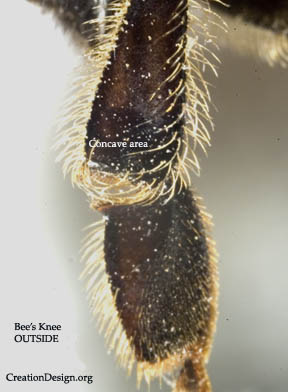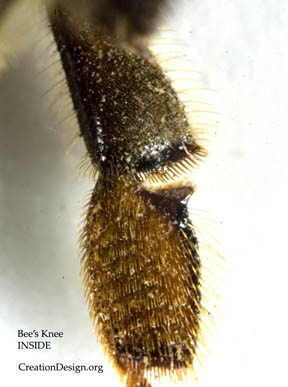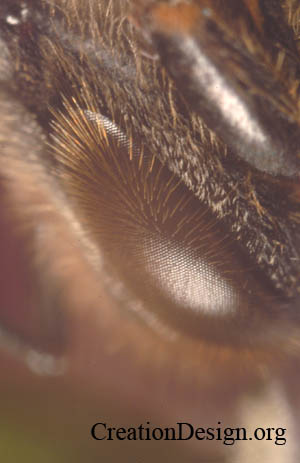
Let us compare the brain of a honeybee to a supercomputer.
The brain of the Honeybee
A supercomputer can compute at the rate of one billion computations per second. The brain of the honeybee can compute at one billion computations in 1/1000 of a second, or a trillion computations per second. The brain of the common housefly computes at approximately 1011 computations per second when merely resting:
"Using the criterion of joules per operation, the brain [of the honeybee] is about 7 or 8 orders of magnitude more power efficient than the best of the silicon chips. A direct consequence of their efficiency is that brains can perform many more operations per second than even the newest supercomputers. The fastest digital computers are capable of around 109 computations per second; the brain of the common housefly, for example, performs about 1011 operations per second when merely resting."
Sejnowski, T.J. and Churchland, P.S. The Computational Brain (MIT Press, 1992), p. 9 (emphasis in the original). Sejnowski and Churchland are well recognized in the field of neurobiology and computational neuroscience and are professors at the University of California. See also Sejnowski, T.J. and Churchland, P.S., 1992, Byte Magazine, October, 1992, p. 137 relating to the computing power of the brain of the honeybee.
However, in the eyes of evolutionary scientists, the brain of the bee is really not that difficult to evolve because it is relatively simple.
Evolutionists have an explanation for how these simple brains came to be.
Their explanation is also simple. They explain that some insects were quicker to escape their predators and quicker to find food, so they survived. But the insects that were slow did not survive because they were either eaten or they could not get enough food. Over millions of years some of the quicker insects had mutations in their brains and muscles that gave them quicker reactions. Since they were quicker than the other insects, they survived and the slower insects died out. It was in this way that brains smaller than pinheads were installed, programmed and wired to successfully compute at a trillion organized computations per second.
Most people who think about that simply do not believe the evolution explanation. But, if you doubt it, don't say so or, according to at least one leading evolutionary scientist, you are a dimwit:
Anyone who does not accept the evolutionary explanation has been publicly defined as a "dimwit" by at least one high profile evolutionist (who will remain un-named).
This is a photograph of the process that evolutionists believe created the brain of the honeybee - and ultimately the brain of man:

The quick bird catches the slow bug
It is a photograph of the survival of the fittest: the quick bird catches the slow bug. Theoretically, the slower bugs were removed by predators and environmental pressures and the quicker bugs were the fortunate recipients of beneficial mutations that made them more able to survive. Evolutionists argue that this process continued until, as stated above, the brains of insects like the bee could compute at a trillion computations per second. That is not a rational conclusion.
The Bee's Knees
 The upper and lower outside portions of the hind legs of the bee are equipped with plates that are designed to hold and to transport pollen. These plates contain a hollowed-out area in the knee on both the upper and lower segments. There are hairs that reach around the hollowed-out area on the upper and lower segment to form a basket-like structure for the purpose of transporting pollen. These hairs hold the sticky pollen together as it clumps over the outside of the knee. In the center there are other hairs that reach across the joint to hold the pollen on the bottom of the upper concave area. These hairs reach downward just far enough to facilitate the loading of the pollen. The loading of the pollen is accomplished primarily through the use of a comb that is placed on the inside of the knee.
The upper and lower outside portions of the hind legs of the bee are equipped with plates that are designed to hold and to transport pollen. These plates contain a hollowed-out area in the knee on both the upper and lower segments. There are hairs that reach around the hollowed-out area on the upper and lower segment to form a basket-like structure for the purpose of transporting pollen. These hairs hold the sticky pollen together as it clumps over the outside of the knee. In the center there are other hairs that reach across the joint to hold the pollen on the bottom of the upper concave area. These hairs reach downward just far enough to facilitate the loading of the pollen. The loading of the pollen is accomplished primarily through the use of a comb that is placed on the inside of the knee.
The inside of the Bee's knee is entirely different from the outside. The inside contains no concave surface for storing pollen or long hairs to hold it, because the knee is designed to transport pollen only on the outside. The inside contains a very pronounced comb that is placed on the inside of the knee joint directly opposite to the slightly v-shaped surface of the lower knee. The Creator designed it this way in order to provide the bee with the ability to preen the pollen off of the numerous hairs on the body and to load the pollen into the pollen holders on the hind legs.  The v-shape construction on the lower joint is designed to form a tiny channel so that the joint may be closed on the antennae or other appendage and the pollen combed off by pulling the appendage through the joint like pulling a thread through a needle. The knee joint also opens to expose the comb to flat surfaces on the bee's body so the bee can comb the honey from its body hairs into the carrying "baskets" on its legs. The long hairs that wrap around the concave area also serve as combs to comb the pollen into the holders. In order to do this, the joints of the hind legs must be designed with extreme flexibility so that the legs can reach the upper body.
The v-shape construction on the lower joint is designed to form a tiny channel so that the joint may be closed on the antennae or other appendage and the pollen combed off by pulling the appendage through the joint like pulling a thread through a needle. The knee joint also opens to expose the comb to flat surfaces on the bee's body so the bee can comb the honey from its body hairs into the carrying "baskets" on its legs. The long hairs that wrap around the concave area also serve as combs to comb the pollen into the holders. In order to do this, the joints of the hind legs must be designed with extreme flexibility so that the legs can reach the upper body.
All of these evolutionary "accidents" must coincide with the instinct of the bee to comb only in the direction that will sweep the pollen on to the outside of the leg and into the "basket" rather than to the inside of the leg. Note that not one stray holding hair is found on the inside of the leg. Why? Not because some accidental mutation removed it, but because it was not part of the intended design.
The bee's knee is, of course, quite small. It can sit comfortably on the tip of a fountain pen. Yet a much smaller space was obviously designed for pollen and even smaller mechanisms such as the comb and the joint were designed to gather the pollen. A bee must work a lifetime in order to carry enough pollen to make 1/12 of a teaspoon of honey.

There can be no question that the bee's knees were designed to collect pollen in order to make honey. The only question is who designed them? Were they really "designed" by accidental changes and survival of the fittest? If so, then where is the evidence to show this? Where are the half-evolved "improvements" to the bee that we should find? Where are the "mistakes" or the other facets that are still evolving?
The Eye of the Honeybee
A major portion of the bee's processing power is dedicated to vision. One portion of this vision is providing the bee with ultraviolet light vision. The purpose for ultraviolet light vision is to enable other portions of the bee's brain to quickly distinguish between flowers with pollen and flowers without pollen (this distinction is easily made with ultraviolet light).
Another function of the bee's processing power is to provide other portions of the bee's brain with an extremely wide, super-fast, moving image encompassing both sides of the bee simultaneously. The speed of resolution and refresh of the bee's vision is significantly faster than that of humans. For instance, if a bee were to see a motion picture, it would not see motion; it would see a series of still photographs. A bee can see a five times the speed of human vision.

This is accomplished through the bee's compound eye that contains approximately 4500 tiny lenses encased in minute hexagonal chambers that record only the type of light that is needful for the bee and only light that is directly in line with the direction of the lens. The lenses are so perfectly aligned that the bee has hairs that extend parallel with the line of sight to protect the eye but not to obscure it. The light from each lens is directed to a photo-receptor called an ommatidium that contains 9 light sensitive cells. Two of the cells record green light, two record blue light, two are variable depending on the position of the eye, and two record ultraviolet light. The ninth receptor cell records polarized ultraviolet light for navigation when the sun is obscure. The purpose of this super-fast visual processing is to enable the bee to fly quickly through dense forests and avoid collisions with leaves or to fly in a swarm of other bees and avoid collisions with them, to navigate in bad weather and to easily locate flowers.*
But navigation in bad weather through the use of polarized ultraviolet light is really not sufficient to enable the bee to travel perhaps miles away from the hive and then find it again. So, evolution explains, the bee accidentally became equipped with the ability to read the earth's magnetic field and thereby determine direction. The abdomen of the bee contains millions of tiny magnetic crystals, which are contained within cells called trophocytes. There is a connection between each trophocytes and the bee's nervous system, which is connected to its brain.* So there is a connection between the magnetic crystals and the brain. Somehow the crystals communicate with the brain and the brain is programmed to read the data gathered from the millions of magnetic crystals and thereby determine direction. So, from the imperceptible magnetism generated by the North Pole and the South Pole, the bee knows which direction it is flying. So a bee, sitting on a flower in total darkness, knows which way it is facing with relation to the distant bee hive.
It is unreasonable to argue that random mutations slowly created and organized billions of neurons that came together in just the right way to provide the processing power for ultraviolet light. Nor is it reasonable to argue that a series of extremely fortunate accidental mutations created a sense that can sense an otherwise imperceptible magnetic field - and then programmed the brain to process the information from millions of sources. Indeed, how could natural selection "know" that there was a magnetic field to be perceived before the receptors, the neurons, the code that relays magnetic perceptions and the processing power to read the code accidentally happened and began to work in harmony?
It is equally unreasonable to argue that millions of unobserved accidental mutations slowly developed blazingly fast compound eyes, developed the codes to define nine bits of light from each separate microscopic lens and that the bee simultaneously developed the neuroprocessing power to read, assimilate, analyze and react to those codes at the rate of a trillion computations per second all because all of the bees that did not have this ability died.
That is no explanation.
One recent report on honeybees addressed the geometric perfection of their honeycombes. This structure has fascinated intelligent observers for centuries. It has been reported that in the 4th century, the Greek geometer, Pappus of Alexandria said, "By virtue of a certain geometrical forethought ... [bees] know that the hexagon is greater than the square and the triangle and will hold more honey for the same expenditure of material ... " See http://news.discovery.com/animals/insects/secret-to-honeycomb-revealed-130717.htm?utm_medium=referral&utm_source=pulsenews#mkcpgn=rssnws1 Even Darwin stated that the honeycomb was "absolutely perfect in economising labour and wax." (id.)
However the cells of the honeycomb do not start out as hexagons but as circles. First a construction bee creates a circular chamber around himself. He then kneads minute flakes of wax and tamps them into place near the triple junctions of the 6 mm cylinder. The bees raise the temperature of the wax to around 113 degrees Farenheit (45 degrees Celsius) and the wax begins to flow slowly. At the junction of the tamped wax, the surface tension causes the wax to stretch and move upwards. This upward motion forms a point that becomes the angle of one side of the hexagon. The above referenced article quotes Britain's Journal of the Royal Society as, "We cannot ... ignore, nor can we not marvel at the role played by the bees in this process by hearing, kneading and thinning the wax exactly where needed."
Pappus of Alexandria was correct when he stated that the formation of the combes as hexagons rather than triangles or squares or circles require some geometric forethought. But that forethought was not supplied by the bees. The bees are born with the knowledge. They are tiny living machines that were themselves constructed.
The primary reason why many scientists argue that mutations and dying bees created computers the size of pinheads that are faster than supercomputers and perfect geometric forethought is because the more reasonable explanation ( the Creator ) is simply not acceptable to them. For these scientists, their science is not really founded upon observation. It is founded upon an impenetrable theological conviction, so they will believe in evolution even if there were no evidence for evolution at all:
"Even if there were no actual evidence in favor of the Darwinian theory ... we would still be justified in preferring it over rival theories [creationism]." Richard Dawkins, The Blind Watchmaker (NY Norton, 1986), 287, emphasis in the original.
Further findings show that bee venom consists of chemicals that poke holes into the protective protein coating that surrounds viruses and bacteria "killing them without harming healthy human cells." One virus that bee venom kills is HIV. This has resulted curing a baby of HIV. See:
http://news.discovery.com/tech/bee-venom-loaded-nanoparticles-kill-hiv-130309.htm
The Creator designed the colony of bees and the entire body of each bee with a purpose in mind. There is no randomness on the bee's body or to the acts of the colony as a whole. The brain, the hexagon, the honey and the knees are examples of the immaculate design found in all aspects of the bee's body and the colony as a whole.
Conclusion
If someone were to view the bee with absolute objectivity, would he or she conclude that it was formed by a series of millions of accidents and the survival of the fittest, or that it was designed by a designer?
If evolutionary scientists were truly objective, they would presume nothing about the Creator - neither existence nor non-existence. And then they would consider the evidence and draw their conclusions from the evidence and the evidence alone.
But evolutionary scientists are not inclined to risk their tenure to advance a radical truth, nor are they inclined to shift a very comfortable theological cornerstone. So evidence like the evidence seen on this page is obscured behind a convenient theory and circumvented with condescending words like "primitive" and "simple." Or words like "dimwit" to refer to anyone who doubts them. And they base their science and their lives on the tragic fiction that blind watchmakers really do make watches.
But there are no blind watchmakers and if there were, they would not construct honeybees with supercomputers the size of pinheads for brains (see conclusion) conclusion.html. Bees are designed and created by a magnificent Designer who created all things.